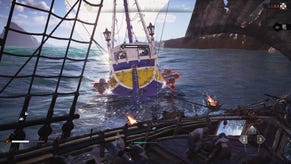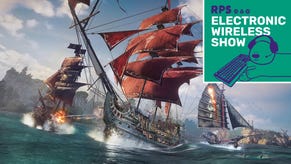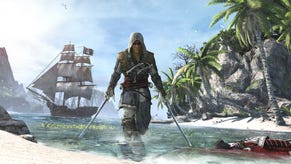Skull And Bones review: an exceptionally boring live service shipping sim
Sunk cost
Ubisoft boss Yves Guillemot recently said Skull And Bones is a "quadruple-A game", which I think is very accurate, actually. "AAAA" is the sound that escapes my lips as I embark on yet another hour-long sail to retrieve some logs, or when I'm doing my little deliveries and a brigantine starts on me. After 11 years in development, Ubisoft's pirate game isn't necessarily a disaster, I just think its live service model has transformed piracy from a roguish lark on the waves into a tremendously dull series of shipping tasks.
Skull And Bones gets off to a good start. Your ship is attacked from all sides, in what's a rip-roaring final stand that sees you wash up in a starting area filled with promise. A small area where levels don't matter and an introduction to a universe and a crew that seem, at first, to hum with rum and roguishness. Unfortunately, the live service scaffolds go up once you've left this opening area.
You're plopped into starter's hub area a bit like Destiny 2's Tower, but more wooden in every sense. Various vendors dot the place, all of them with fetch quests to accept and nothing interesting to say. In the big hut is where you'll meet Captain Scurlock, a primary quest giver who'll steer you through a main storyline that's marginally less tedious than the rest.

To become a pirate overlord is to level up two things: your Infamy rank and your ship rank, both of which feed into each other. Most things you undertake - completing quests, destroying other ships, discovering new locations - nets you Infamy, with higher Infamy ranks letting you unlock stronger blueprints to craft better ships, cannons and the like. Your ship rank, meanwhile, is determined by the collective power of the ship itself and the weapons you've slapped on it.
As you'd expect from an open world Ubisoft game, the map is a vast noticeboard with lots of icons pointing to various resources: raw materials such as trees and cobalt you'll harvest by parallel parking, then performing a little minigame. Islands big and small are home to forgettable factions, some with encampments you can barter with or plunder, the latter granting you extra goodies if you awkwardly float within a red zone and sink progressively tougher ships. And as you venture into the far reaches of the ocean, everything largely remains the same except that everyone's levels are higher and the resources rarer.
Skull And Bones centres around stuff and things, where piracy is entirely motivated by a need to get the blue rarity cannon that's marginally better than your green rarity one. You'll idle along trade routes, scanning ships with your spyglass in the hopes that a pop-up says it holds the bits you're after, lest you spend one more iota of your precious time bobbing on the ocean.
And that is, perhaps, the game's most damning offence: your heart sinks every time you come into contact with water. Sailing in Skull And Bones doesn't even attempt to capture or educate us on some of the thrills and challenges that I'm sure come with real life sailing. Instead, it's a case of moving forwards and occasionally tweaking the angle of your ship so the wind better catches your sails, and doesn't hammer the front of your ship, slowing you down. It's still very Assassin's Creed IV, in other words, and all the while, you'll have the 'pleasure' of replenishing an ever-depleting stamina bar by popping open a radial menu and quick-selecting the likes of grilled coconuts (possibly the most direct interaction you'll ever have with your crew).
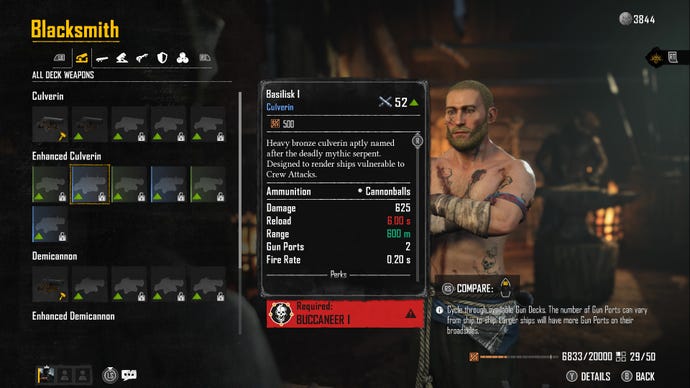
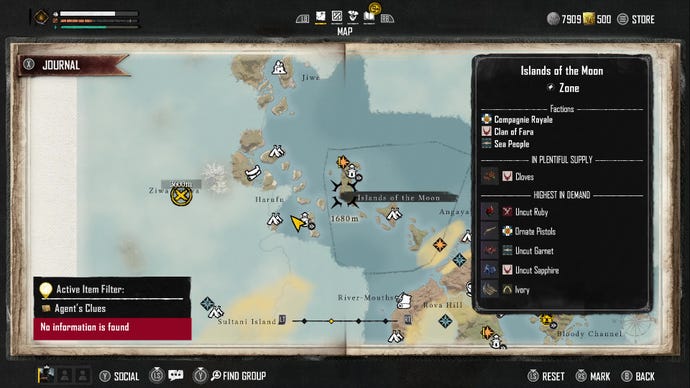
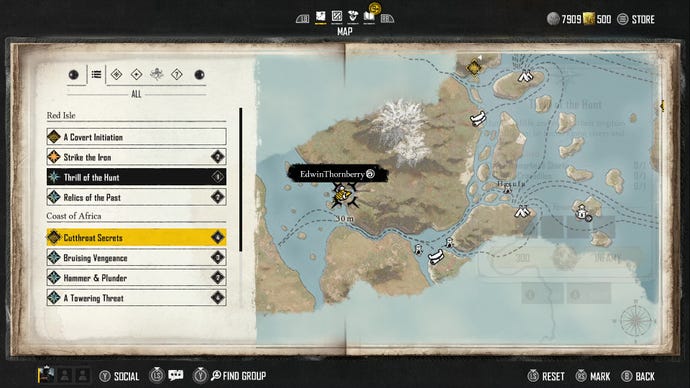
Head out into the 'open sea' and you'll get flashes of what could've been: an ocean rife with ever bigger waves and tremendous gusts of wind; groups of ships spitting cannonballs at one another; or rogue traders in a "Don't even try it" formation. These brief blips go a long way to break you out of your slumber, but they are sadly few and far between. Most of the time, the sea feels like a viscous slurry corrupted by a cruel live service model that has you forever crave the immediacy of fast travel. I'm not kidding when I say countless episodes of MTV's Catfish and a series of Japanese language learning videos got me through each expedition.
Is there any joy on any of the surrounding rocks? Not a great deal. Islands owe all of their excitement to being fast travel points, otherwise acting as mini-hubs home to listless traders who'll offer you more fetch quests, materials, and blueprints. Run about and you might bump into some buried treasure, which will net you some rarer stuff and things.
To make use of all the cargo you're hauling around is to engage with the game's live service pathway, and it's one that left me feeling lost at sea. Often, service games like Destiny will have a main storyline that'll guide you towards each of its offshoot reward tracks, granting you meaningful rewards, and handing you off to late game challenges. By the end of Destiny's campaign (at least, as I remember it), you've got a suite of moreish activities that'll make you want to log in everyday and get yourself closer to the peak: Raids, PVP, and the like. Most importantly, the main quest line will have left you at a point where you're powerful enough to get stuck in and chase those level caps.

Complete Scurlock's questline and there's a high chance you'll leave it both underwhelmed and underleveled. By the time I completed it, I was at least three levels below the next region's questline (a Scurlock equivalent) and couldn't so much as scratch enemy ships who patrolled those waters. Sure, it's the game saying, "Time to complete some contracts, level up, and improve your ship!" But it's an agonising process when the contracts and their rewards leave you short-changed.
The main way to power up, outside of the endgame at least, is to visit the blacksmith or the shipwright. It's here where you're able to craft new weapons and new ships, so long as you've got the materials and, crucially, the pissing blueprints. To obtain these blueprints, the game forces you to buy them from vendors scattered all over the seas, as well as up your Infamy rank to unlock better versions.
Now, bounties, quests, whatever it is you've done, often reward you with Infamy that'll barely raise the bar, zero materials, and about as much silver (money you use to buy things including blueprints) as you'd get if you melted down a Tesco trolley. Not only does the act of endless sailing compound the agony, but the 'better' stuff rarely ever results in a jump in your overall ship level (or, indeed a yelp of excitement). The best live service efforts at least reward you frequently, giving you guns with unique names, their borders radiating with power. New boots with sockets for gems. A mount to speed up traversal. But Skull And Bones rarely ever puts its hands in its coffers and gifts you treasure befitting a pirate fantasy. Rather, it expects you to put in the grind and craft everything. It's a deeply ungenerous game.
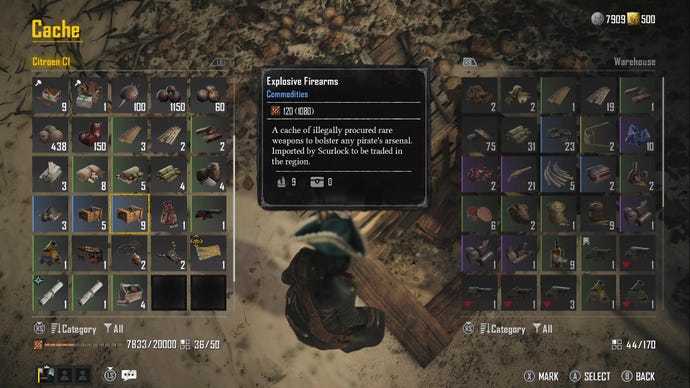
Still, there's some joy - joy teetering on relief - to be had when you finally, finally obtain something better. It's at the Docks where you can customise your ship, with bigger ships able to accommodate more weapons and furniture. That's right, your ship's build is determined by pieces of furniture like rope lockers and rigging stations. My ship is affectionately named "Citroen C1", and is a DPS type boat, with a shotgun-like cannon on one side, a fire bombardment on the front, and some sniper rifles on the other side. Your crew? They may as well not exist. You are a boat in Skull And Bones and as far as the game's concerned, and that's that.
And there's some happiness to be found in combat, which is simplistic, approachable fun for folks who enjoy sidling up alongside other boats and slamming metal into their sides. Watching wood splinter as big red numbers spring off a big red zone you've hit, is admittedly, a brain receptor tickler - much as it was, and is, in Assassin's Creed. Really, though, levels are all that matter, not positioning. The only real strategy lies in hitting button prompts that let you fire muskets to secure extra damage, or 'board' ships - though here you don't even get the thrill of doing the actual boarding as you would in Ubisoft's time-hopping murder'thon. You are a boat, after all, not an Assassin captain, and all you get is a mere cutscene instead, the end result being some more netted bonus materials.
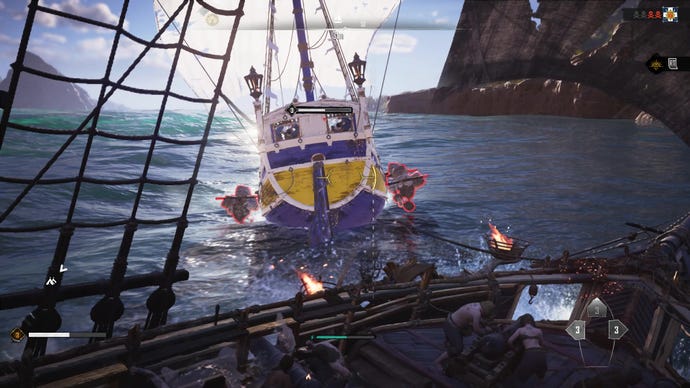
But the combat simply isn't deep or engaging enough to keep you coming back for more, especially when Skull And Bones begins to lean into its end-game, which centres around more deliveries. To get 'Pieces Of Eight', a new currency that lets you purchase some of the best gear, the game wants you to get sugar cane, refine it into rum (later, berries into opium) and deliver it to people. The challenge stems from fast travel being disabled and AI-controlled boats chasing you down.
Truthfully, I couldn't bring myself to reach the farthest corners of the end-game, where seemingly, there is a sea monster and tougher ships to battle. Life is too short and my mental wellbeing too important to put myself through an experience that genuinely drained every drop of life out of me. I may have managed the slog with pals, but to me, multiplayer seemed largely non-existent anyway. I rarely ever saw anyone else, and if I did, we'd bob together while plundering zones then drift away the moment they ended. Sometimes the game would prompt people to get together to tackle a big baddie or engage in some optional PVP, but no-one ever showed up.
I think Skull And Bones might be one of the most boring games I've ever played. There might be value in it for those looking for a leisurely sail, or folks who enjoy the time management side of making deliveries optimally. For everyone else, boat-lovers, live service fiends, and people who like fun, the game will be nothing more than a tedious slog through unrewarding waters.
This review is based on a retail build of the game, provided by publishers Ubisoft.


